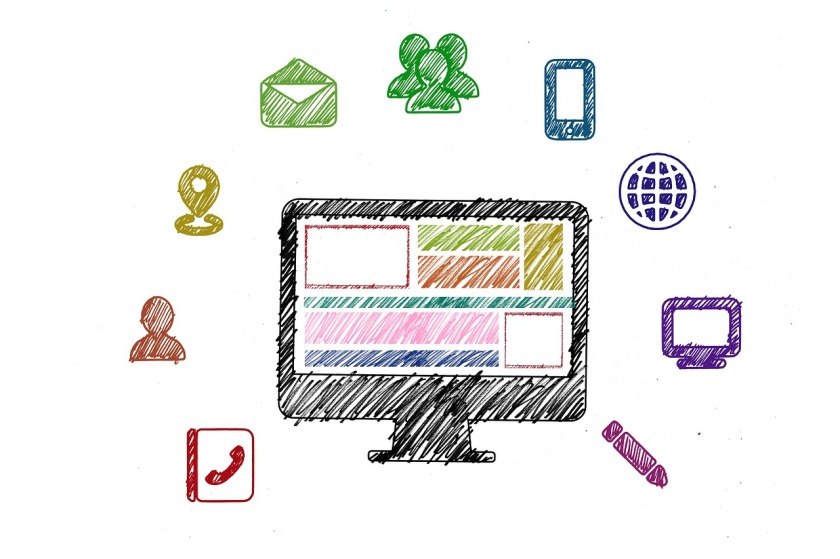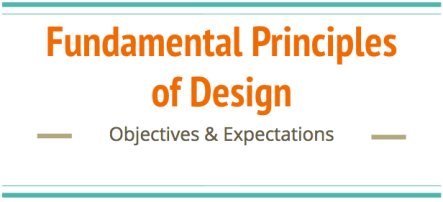
I am back at it! But this time I get to design my course and dive deep into organizing and gathering content. I had to think back when I researched my own learning style and my BHAG: Upon completion of Digital Media, students will be capable of performing, interacting and applying critical thinking skills in a technology-driven society; while making contributions to emerging technologies and collective communities. My goal still remains the same and I have made huge steps towards fulfilling my innovation plan.
Digital Media Course Outline
One project down! I have intended to really develop the Fundamental Elements of Design for years now. I have finally organized a 5 week project designed for the start of the year to allow students to explore their creative freedom while introducing Illustrator skills necessary for future projects. Check out my Digital Media Outline if you need ideas to get started. I focused heavily on typography since each project going forward will include the importance of communicating through type. The end product will be hand held cards reminding students of the elements of design to be used as a personal resource from project to project. I think they will find success as the cards become a tool for future design solutions.
Time to Build and Reflect
Since I have become an early college teacher I have learned to love scaffolding, like a “carpenter building a house” (Scaffolding for student success, 2015). I have always chunked information and skill building, but never put true meaning to it other than getting what I wanted out of a project. And I truly mean “I” and not my students. I am also guilty of never going back and reflecting on projects students tanked. I just didn’t care, because no one else seemed to value an elective course. Now, reflection is crucial to the process for all my students. At times I do rush the process so I can move forward faster. I have been fortunate to be successful with my lessons without much planning in the past, as Bates would call it an “in-born talent” (Bates, 2015). As I move forward in my career as an educator this talent I natural have does not cut it with more advanced thinkers! I have to be honest with my imperfections and lack of knowledge, but be willing to work hard to find solutions with my students. Having previous knowledge on how LMS’s work definitely allows more time to narrow my focus on the missing pieces of my projects. I find myself reflecting more than I ever have and it feels so good to know I have been able to learn from my failures and rework broken projects.
Expectations
Often as educators we overlook the importance of setting expectations, not only with our students but with ourselves first. If I were to focus on an area where I should have the highest expectations as a teacher the truth would be in planning. During our last Focus Friday, our instructional coach stressed the importance of planning and the value in creating clear objectives and expectations for each lesson. As I build out my 5 week course in Schoology, I reflect on my materials and if they are “thoughtfully planned.” I am not an online teacher at the moment. Debbie Morrison explained how instructors have “to be strategic and purposeful in their communication with students, and requires a different perspective” (Morrison, 2013). I wonder what the different perspective looks like? I believe I am in the process of learning this different perspective since I am an online learner, specifically for my graduate degree. I now have a view from learning traditionally at a private college, online for my masters and as a teacher at a problem based early college. After looking over my course, I decided to go back and and create a weekly agenda with clearer objectives and expectations as a way to communicate better with my students.
Week 1
Week 2
Week 3
Week 4
Week 5
Hopefully, these online agendas will give my students and myself a better path from class to class and help me move through my TEKs with more success. By creating these presentations in Google Drive, I will be able to update and modify as needed.
Redesigning
If I had to choose two courses to redesign for online learning my picks would be Graphic Design I and Video Production I.
Graphic Design I: Next year I will be picking up Graphic Design I. The current teacher teaches straight from the book, which is why I get to teach it. I plan on reaching out to the community this summer to find authentic projects so students can design for a reason. I will be able to present my Fundamental of Design Elements to both Graphic Design and Digital Media classes. This project is strong and fundamental to both classes.
Video Production I: I have enjoyed each animation and video production project my students have completed in my Digital Media class. I think it will be an easy task to extend my knowledge of videography and revamp the two video production classes on campus. I would start with basic stop motion and have students build videos in simple applications such as iMovie or Adobe Spark online, then progress to Adobe Premiere and Adobe After Effects. I can also spend time in Adobe Character and Animate, which I have not been able to get to in Digital Media
Successful Online Courses
- Lynda.com from Linkedin: Lynda.com
- Adobe Education Exchange: edex.adobe.com/
- Everfi: http://everfi.com/
- Coursera: www.coursera.org/
- iTunes U: itunesu.itunes.apple.com/coursemanager/
- Linkedin Learning: www.linkedin.com/
- Class-Central: www.class-central.com/subject/k12
- Connections Academy: www.connectionsacademy.com
- Khan Academy: www.khanacademy.org/
- Apex Learning: www.apexlearningvs.com/
- EdX: www.edx.org/
- K12: www.k12.com/
Final Thoughts

“There is no replacement for good teaching, the role is just evolving.” – NMC/CoSN
Instructional Design Theories
Constructivism and connectivism theories are the two instructional design theories relevant to the development of an online course in my opinion. Lately, connectivism has drawn my curiosity, especially with tactic learning and the power of networking. Self-directed learning is a huge component to online learning and would not be as popular without having a motivated individual. Overall, the constructivism theory, also known as the theory of knowing, fits well with the way I designed my online course. Constructivism is not predictable learning and allows a more social approach to solve problems. As a learner myself, I enjoy using my creativity to solve problems and finding intrinsic motivation through constructing my own knowledge. Constructivism fits best with problem-based learning, incorporating inquiry, scaffolding and building self-efficacy. Constructivism clearly stands out as my top pick due to the nature of the early college environment. When student agency is gradable, expectations for projects look diverse and nontraditional. My goal is to bring in authentic projects so students can gain life experiences and have the ability to reflect to further their knowledge. Building relationships among learners’ online taps into a fountain of unknown knowledge and allows for higher-level thinking to happen. Student engagement is also higher when students collaborate on shared experiences. Constructivism reshapes the way students learn in an online learning environment.
UbD Plan
The UbD plan is a great starting point to any online course, especially if it’s your first to design. Implementing the plan helps align with the needs of my learners and the learning objectives (Pappas, 2017). I think it is relevant for beginners and has helped me set goals and helps me think through where I am going… WHERETO. The plan also directs me to my why, the most important aspect of any course development. As I reflected back on my initial UbD plan, I soon realized it was going to get wordy really fast! My first plan was well organized, but it did not include all five weeks, maybe just two. Perhaps I developed it too much and did not give enough thought to the actual assignments which I needed to create to add to the course. I plan to use the template online so I can add in links and any materials I need. I will simplify my language for my learners and only give the necessary resources. We have a similar project template in my district which simplifies the process for designing projects. In the future, I will cross-reference each tool to make sure I am creating learning opportunities for my students and provide a digital format for flexibility.
Importance of Providing Online Learning
Online learning gives the learner an opportunity for authentic learning and not an artificial example (Knezek, 2011). As an online learner, knowledge is built together though discussion and discovery through shared experiences. Online learning is shaping the way we learn while giving more opportunities and flexibility to all learner styles. Self-directed learning allows students to take full responsibility in their learning in a dynamic way. Students no longer have to sit in a static learning environment, they now can take ownership of their own learn using a variety of digital resources. As students find their careers, lifelong learning must be a priority. With the demands of today’s job market, having the ability to learn online helps you stay competitive in your field and new emerging careers (Snyder, 2013). Online learning also provides 21st century skills necessary for future employment. Students gain a network of information and build a chain of valuable relationships for future success.
Successful Online Programs
Instructional design is messy! No matter what template you use to organize your thoughts and course objectives, always prepare for plan B. Instructional design requires me to be strategic and purposeful in the way I present my materials (Morrison, 2015). I have to be open to a different perspective of the way learning is transferred from one student to another. Quality matters. Learning to select worthy online materials and articles can be challenging, but it’s worth the time. Outcomes in my course can and should be measured. It’s essential to develop a system that allows assessment and feedback. Trust the process. Having defined goals are important to build stability during the course and allows students to meet benchmarks on their own learning path. Online learning takes a team of knowledge. Staying flexible in my application and instruction will be an advantage for future changes in technology. Modeling this flexibility will support the learning experience for my students as well. I am responsible for teaching my students how to learn so they have more opportunities for deeper understanding. Like a gardener, tending to my garden of learners… I can plant the seed, add the nutrients and love, but ultimately, it’s up to the learner to grow (Bates, 2015).
References
(2015, January). Scaffolding for student success. Inspiring Education. Retrieved from https://amara.org/en/videos/NltxJmWxljmq/info/scaffolding-for-student-success/
Bates, A. W. (2015, Dec. 14). Dr. Tony Bates on building effective learning environments. Retrieved from https://www.youtube.com/watch?v=3xD_sLNGurA
Bates, A.W. (2015). Teaching in a digital age: guidelines for designing teaching and learning. Retrieved from https://opentextbc.ca/teachinginadigitalage/
Knezek, D. (2011). Perspectives: Teacher skills in a digital age. Retrieved from https://amara.org/en/videos/R3sGzvS202Kq/info/perspectives-teacher-skills-in-a-digital-age/
Morrison, D. (2015, Aug. 23). More essential and helpful resources for online instructors. Retrieved from
https://onlinelearninginsights.wordpress.com/2013/08/26/essential-and-helpful-resources-for-online-instructors/
NMC/CoSN (2016). Horizon Report 2017 K-12 Edition. Retrieved from https://www.nmc.org/publication/nmccosn-horizon-report-2017-k-12-edition/
Pappas, C. (2017, Sept. 2). Top 7 Instructional design theories & models for your next eLearning course. Retrieved from https://elearningindustry.com/top-instructional-design-theories-models-next-elearning-course
Snyder, T. (2013, April 1). The benefits of online learning. Retrieved from https://www.huffingtonpost.com/tom-snyder/the-benefits-of-online-le_b_2573991.html

